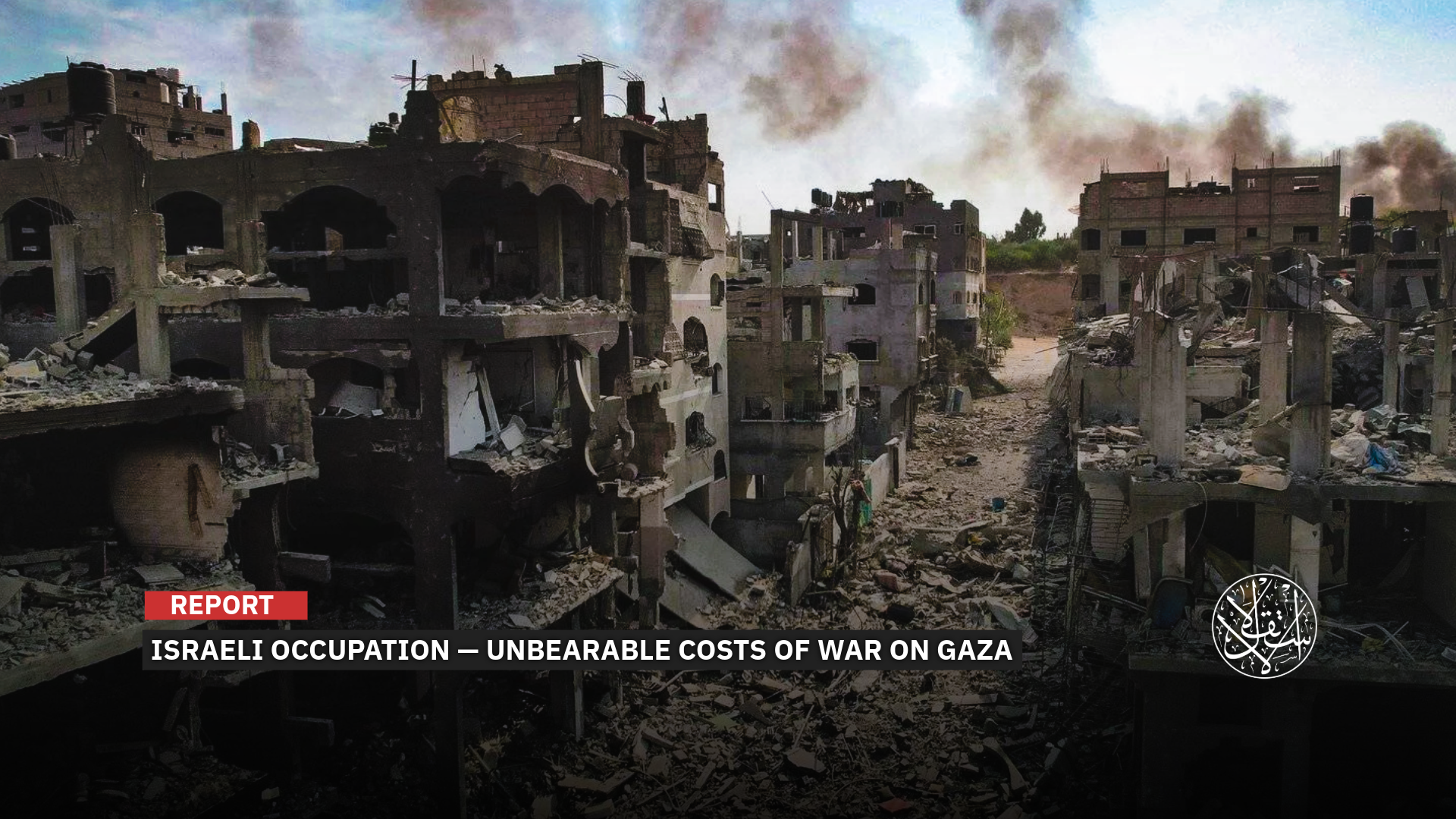Astronomical Costs: Why Has ‘Israel’ Increased Its War on Gaza Budget Fivefold?

“The Israeli Occupation economy looks like a ticking time bomb.”
The economic toll of “Israel’s” war on Gaza is rattling Israeli Occupation society, with mounting warnings of catastrophic fallout for ordinary households if the Israeli government follows through on its August 20, 2025, plan to occupy Gaza City.
Economists, bank chiefs, and “Israel’s” financial press fear that the continuation and expansion of the Israeli war, along with Prime Minister Netanyahu’s insistence on occupying all of Gaza, could spell disaster for “Israel’s” economic future, as the costs of war are already weighing on the budget.
They stress that the damage and expenses are not only internal, in the form of cutbacks to other ministries, soaring military spending, rising deficits, slower growth, and a downgrade in “Israel’s” credit rating.
The impact is also external, with growing economic and academic boycotts pushing the Israeli Occupation closer to the point when countries, corporations, and investors will walk away from doing business with it because of the massacres in Gaza.
The clearest and most recent sign of deep anxiety over an impending economic crisis came when “Israel” was forced to breach the national budget for the fifth time since the start of its war on Gaza in order to increase military spending, further widening the deficit.
Five Times
For the fifth time since the aggression on Gaza began, the Israeli Occupation government approved an additional budget to cover its war expenses, totaling 28.9 billion shekels (about $8.5 billion). It was a troubling indicator for Israelis.
This marked the fifth breach of the budget to fund the war on Gaza.
The first breach came in October 2023, after Operation al-Aqsa Flood, followed by three breaches of the 2024 budget, and now a fifth with the 2025 budget.
Out of an additional 30.8 billion shekels (around $9 billion) added to the Israeli government budget, 28.9 billion shekels ($8.5 billion) were allocated to the war, meaning nearly all of the increase went to the Israeli Occupation army.
The new $8.5 billion for the war budget coincided with cuts of at least 11% across other ministries, prompting Israeli newspapers to warn of accelerating economic contraction, shrinking growth, and a swelling deficit.
With the latest increase, this year’s total war spending reaches more than 140 billion shekels (about $41 billion), approaching the 2024 war budget of 160 billion shekels ($47 billion).
On August 10, Yedioth Ahronoth quoted Israeli officials as saying that maintaining full control of Gaza after “a military takeover” could cost between 10 and 15 billion shekels ($2.7 to $4 billion) every month.
That would amount to between 120 and 180 billion shekels ($32 to $48 billion) annually, excluding the costs of the war itself or the broader economic losses.
“Credit rating agencies, all of which have already issued a negative outlook for Israel, may soon downgrade Israel’s rating to levels seen in less developed countries,” a senior Finance Ministry official told Ynetnews.
On August 19, Globes cited economists warning that the deficit ceiling for this year’s budget could rise from 4.2% to 5.2% because of the war.
The Finance Ministry has cut its 2025 growth forecast to 3.1%, amid expectations of contraction and stagnation.
As a result, the Israeli Occupation government will raise the spending ceiling from about 620 billion shekels, approved only five months ago, to 650.3 billion shekels.
The combination of higher government spending, widening deficits, and a mounting foreign debt burden will weigh heavily on “Israel’s” economic indicators, likely prompting another downgrade in its credit rating.
“Israel’s” war budget now ranks thirteenth in the world in absolute terms, but second globally relative to gross domestic product.
Only Ukraine ranks higher, allocating about 22% of its GDP to defense. Israel follows with nearly 7% of its GDP devoted to war in 2025.
By comparison, NATO countries spend an average of just 2.7% of GDP on defense.

300 Billion Shekels
Economic analyst Hagai Amit estimated in The Marker on August 10, 2025, that the cost of “Israel’s” war of genocide on Gaza could reach about 300 billion shekels (roughly $87.5 billion).
Amit said the war would push up “Israel’s” foreign debt, now at about 6% of GDP, while raising the government deficit to nearly 4.5% of GDP.
Finance Minister Bezalel Smotrich confirmed on August 6 that the war on Gaza had already cost the Israeli treasury 300 billion shekels. He expressed hope of occupying the Gaza Strip as well but sidestepped questions about the cost of such an occupation and its burden on the Israeli Occupation’s economy.
“Israel’s” economy contracted by 3.5% in the second quarter of 2025 compared with the first quarter, according to figures released by the Central Bureau of Statistics on August 17, 2025.
The data also showed that per capita output fell by 4.4% from the previous quarter, on an annualized basis, dropping back to 42,000 shekels, the same level recorded in the last quarter of 2022.
Private consumption per capita declined by 5.1%, with a steep fall in spending on durable and semi-durable goods.
What troubles Israelis even more is that their own economic press reports that the country will bear a heavy additional burden if it occupies Gaza, including the cost of supporting more than two million people there.
Feeding Gaza’s population alone is estimated to cost 3.4 billion shekels annually. Added to the costs of the war and the repeated budget breaches it has forced, this raises pressing questions about “Israel’s” financial sustainability and the long-term economic toll of the war.

The Costs of Occupation
Yedioth Ahronoth reported on August 10 that Finance Ministry estimates put the annual cost of occupying Gaza between 120 and 180 billion shekels (about $48 billion).
That burden could push the fiscal deficit to around 7% this year, trigger another downgrade of “Israel’s” credit rating, and further strain the 2026 budget.
Officials from the Finance and War Ministries estimate that the daily cost of mobilizing reserves and equipping troops is about 350 million shekels ($94 million). That translates into 10 to 11 billion shekels ($2.7 to $2.9 billion) each month, and as much as 50 billion shekels ($13.4 billion) by year’s end, depending on the length of the genocide.
The Jerusalem Post quoted Professor Elise Brezis on August 11, 2025, estimating the cost of occupying Gaza at 50 billion shekels annually. Her figure includes the expense of mobilizing and arming reservists, in addition to the annual food supply for Gaza’s population, put at 3.4 billion shekels.
Brezis underscored the long-term economic toll of a mass call-up. “They aren’t working, they aren’t learning. These are the young people who represent the next generation of our human capital. The problem isn't how much Gaza will cost us, it’s how much the war will cost us.”
She noted that even after occupying the Strip, security expenses will remain high. “The military will manage the Strip. It will stay the same. You won't send a tax clerk; you’ll send a soldier.”
Other Israeli assessments reach similar conclusions. A study by the Institute for National Security Studies in April 2025, projected that maintaining “military control” over Gaza could cost 25 to 30 billion shekels each year, including about 20 billion for “military operations” and another 5 to 10 billion for running a basic civil administration and providing minimal services.
Drenched in Blood
This prospect prompted two former governors of the Bank of “Israel,” Karnit Flug and Jacob Frenkel, to issue a joint warning in Yedioth Ahronoth on August 19, 2025. They cautioned that the plan to occupy Gaza could inflict massive damage on the resilience of “Israel’s” economy and on the welfare of its citizens.
They stressed that taking control of Gaza and its 2.2 million people would not just be another step in a drawn-out and bloody war with dangerous implications for Israelis and captives alike. It would also deepen “Israel’s” economic vulnerability and contraction.
The former governors pointed out that the Geneva Convention of 1949 obliges the occupying power to restore order and meet the humanitarian needs of the population under its control. That means “Israel,” if it fully occupies Gaza, will be responsible, at least in part, for reconstruction costs and for providing essential services such as health care, education, and utilities.
The World Bank, the United Nations, and the European Union estimated in February 2025 that rebuilding Gaza would cost $53 billion, or about 180 billion shekels. Since then, the Israeli Occupation has launched “Operation Gideon’s Chariots,” causing widespread new destruction and pushing reconstruction costs even higher.
Flug and Frenkel put the annual cost of the war itself at 10 billion shekels, while estimating the expense of setting up military and civil administration, figures that align with those of the War Ministry, at more than 20 billion shekels per year.
The external toll could be equally damaging. The former governors noted that the Government Pension Fund of Norway, the largest in the world, has already divested from 61 Israeli companies and warned that other funds are likely to follow.
Calls are also growing in Europe and the United States for scientific and academic boycotts, which would undermine cooperation and funding critical to “Israel’s” high-tech sector. That industry has been the main engine of growth in recent years, accounting for more than half of exports and a quarter of direct tax revenues.
Haaretz editor Aluf Benn mapped out these looming damages in an August 19 column, pointing to suspended trade agreements, divestment, arms embargoes, and the closing of doors to Israeli Occupation researchers at universities worldwide.

Three Consequences
Economic analyst Eugene Kandel wrote in an article for “Israel’s” Channel N12 on August 14, 2025, that the Israeli economy “looks like a ticking time bomb.”
He noted that it was already facing a series of structural problems before the war. A study published in August 2023 even predicted that “Israel’s” economy would become “unsustainable within two or three decades at most.”
“When October 7th [Operation al-Aqsa Flood] and the ongoing war that followed arrived, they brought that forecast of collapse significantly closer,” he wrote, citing the soaring costs of war.
Kandel outlined three main economic consequences. First, a one-time direct cost estimated at about 200 billion shekels.
Second, a major loss of output as employees and workers spend months serving in the army reserves, compounded by damage to commercial activity, international isolation affecting economic ties, and shrinking tax revenues.
Third, a lasting increase in the ongoing war budget. For at least the next decade, annual costs are expected to reach about 40 billion shekels, not including the high expense of compulsory and reserve military service.
As for the broader economic impact of expanding the war on Gaza, analyst Hagai Amit warned about the financial fallout of a full occupation of the Strip.
He said the decision to take control of Gaza would be one of the most financially costly decisions this government has made in the current war.

Three Risks
Amit warned that this decision would impose a massive burden on the Israeli economy, consisting of three main risks.
The first cost factor is the “military operation” itself. “Operation Gideon’s Chariots” cost Israeli taxpayers about 25 billion shekels in just two months. Full occupation of Gaza, expected to last five months and requiring around five army divisions, would cost double that, nearly 50 billion shekels.
In addition, mobilizing about 480,000 reservists would keep the Israeli economy in a state of constant emergency.
The second cost factor is the expense of providing for Gaza’s needs under “Israel’s” obligations as an occupying power under international law.
The third cost factor is political and diplomatic: dozens of countries recognizing a Palestinian state, Germany partially banning arms sales to “Israel,” and Israeli war and arms companies struggling to win new tenders in Europe or even fulfill existing contracts.
Amit, writing in The Marker, predicted that “Israel’s” international standing would decline with the beginning of an informal boycott of its goods and military industries, along with academic, cultural, and artistic boycotts, all while the government continues to finance and expand settlements.
He said these factors are like a snowball rolling downhill, inevitably leading to cuts in government ministry budgets, shrinking investment, reduced public spending, rising deficits, higher foreign debt, and costlier international loans.
He stressed that this is an economic spiral that will be difficult to escape from as long as political and ideological motives keep driving the ongoing war of extermination in Gaza.
On July 29, 2025, Haaretz also warned that “Israel” is rapidly approaching the moment when countries, companies, and investors abandon trade with it because of the massacres, genocide, and starvation in Gaza.
Sources
- Israeli economy contracts by 3.5 pct in Q2
- Astronomical Costs of Occupation: Israel Set to Shoulder Economic Burden of 2 Million Gazans
- Cost of Israeli control of Gaza could exceed $50 billion a year, estimates show
- How much will Gaza occupation cost Israel? Expert weighs in
- Analysis | The Moment Is Fast Approaching When Countries, Companies and Investors Give Up on Business With Israel
- Opinion | Boycotting Israel Will Only Help Netanyahu and His Authoritarian Regime
- The War Will End, but the Bill Is on Its Way: Who Will Pay the Price? [Arabic]
- Former Bank of Israel Governors: Gaza Occupation Deals a Severe Blow to Economic Resilience [Arabic]
- Takeover of Gaza City could cost Israel NIS 100 billion, expert estimates











